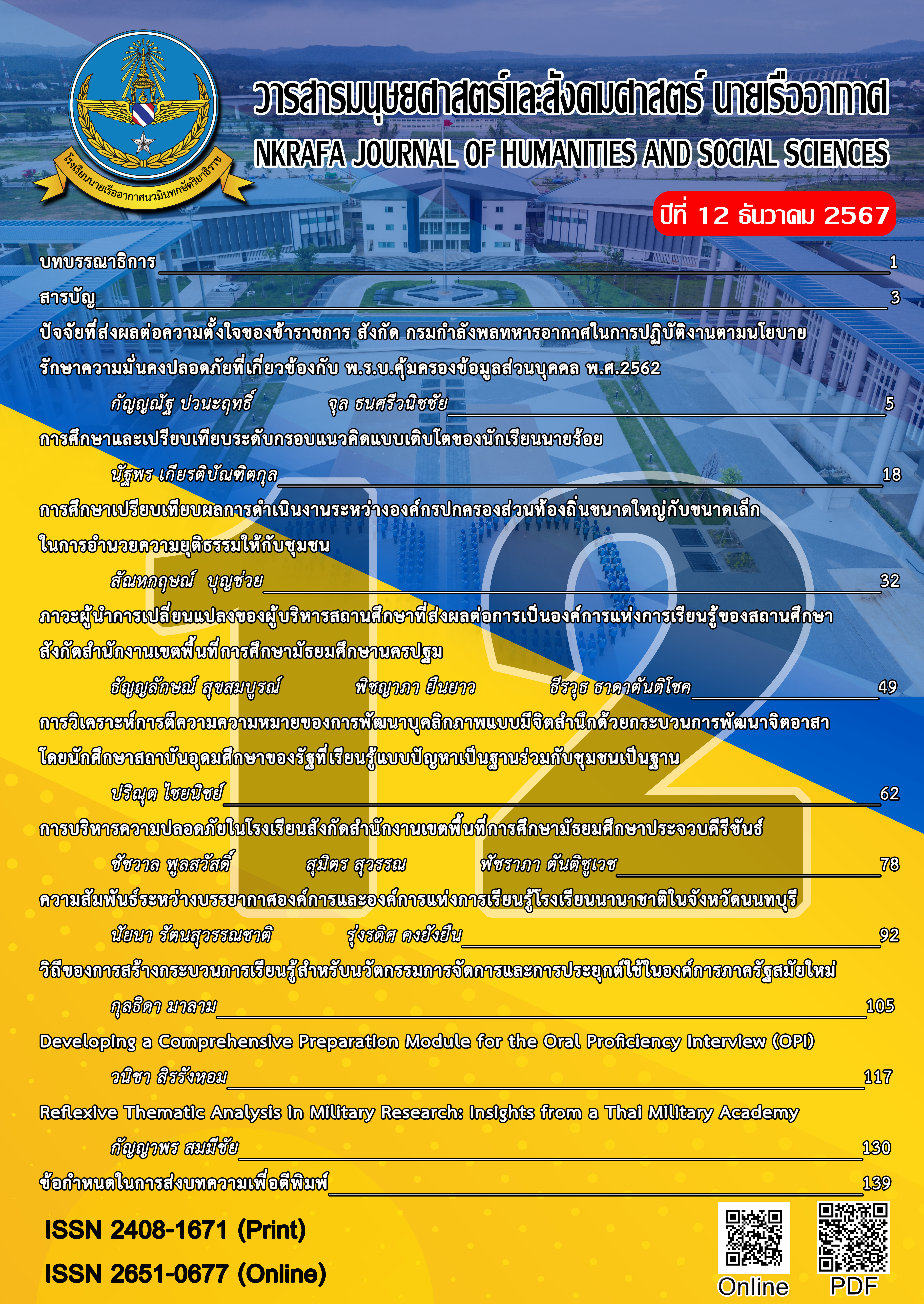วิถีของการสร้างกระบวนการเรียนรู้สำหรับนวัตกรรมการจัดการและการประยุกต์ใช้ ในองค์การภาครัฐสมัยใหม่
Main Article Content
บทคัดย่อ
บทความนี้มีวัตถุประสงค์ 1) เพื่อศึกษาแนวคิดเกี่ยวกับองค์การสมัยใหม่ ซึ่งเป็นรูปแบบขององค์การภาครัฐ
ในยุคปัจจุบันที่จำเป็นต้องมีการปรับตัวให้สอดคล้องกับสภาพแวดล้อมที่มีการเปลี่ยนแปลงอยู่ตลอดเวลา จึงทำให้
การสร้างกระบวนการเรียนรู้ใหม่ เพื่อปรับปรุงระบบการจัดการและกระบวนการทำงานขององค์การ และ 2) เพื่อศึกษาแนวคิดเกี่ยวกับการเรียนรู้ขององค์การ ซึ่งจะช่วยส่งเสริมให้เกิดการนำนวัตกรรมการจัดการไปประยุกต์ใช้กับภาครัฐ
ได้อย่างมีประสิทธิภาพ
องค์การภาครัฐสมัยใหม่ต้องเผชิญกับสภาพแวดล้อมภายนอกที่ผันผวนตลอดเวลา จึงต้องมีการปรับปรุงโครงสร้างอำนาจหน้าที่และจัดระบบกระบวนการทำงานใหม่ ซึ่งการพัฒนาศักยภาพขององค์การสำหรับสร้างพื้นที่
แห่งการเรียนรู้ใหม่ ๆ โดยใช้เทคนิคการเรียนรู้และพัฒนานวัตกรรมการจัดการระหว่างสมาชิกในองค์การ ประกอบด้วย 4 รูปแบบ ดังนี้ 1) การเรียนรู้โดยการรวบยอดความคิดและนำไปสู่การปฏิบัติ 2) การเรียนรู้โดยการนำความคิดรวบยอดนั้นไปใช้อย่างต่อเนื่อง 3) การเรียนรู้โดยการสะท้อนผลสัมฤทธิ์จากการนำความคิดไปใช้ระหว่าง
ผู้ทำหน้าที่พัฒนานวัตกรรมกับผู้ที่นำนวัตกรรมไปใช้ และ 4) การเรียนรู้โดยการเปรียบเทียบความสำเร็จและความล้มเหลวขององค์กรอื่น ทั้งนี้ การประยุกต์ใช้นวัตกรรมที่มีประสิทธิภาพอย่างต่อเนื่องจะทำให้องค์การเกิดการเรียนรู้ซ้ำ ๆ
จนนำไปสู่การเป็นองค์การแห่งการเรียนรู้ในอนาคต และกรณีตัวอย่างการประยุกต์ใช้นวัตกรรมการจัดการทั้งในภาครัฐไทยและภาครัฐต่างประเทศยังสะท้อนให้เห็นถึงรูปแบบของนวัตกรรมการจัดการที่ภาครัฐสมัยใหม่นำมาเป็นเครื่องมือสำคัญในการส่งมอบบริการให้แก่ประชาชน
Article Details

อนุญาตภายใต้เงื่อนไข Creative Commons Attribution-NonCommercial-NoDerivatives 4.0 International License.
บทความที่ได้รับการตีพิมพ์เป็นลิขสิทธิ์ของวารสารมนุษยศาสตร์และสังคมศาสตร์ นายเรืออากาศ
ข้อความที่ปรากฎในบทความแต่ละเรื่องในวารสารวิชาการเล่มนี้ เป็นความคิดเห็นส่วนตัวของผู้เขียนแต่ละท่าน ไม่เกี่ยวข้องกับโรงเรียนนายเรืออากาศฯ และคณาจารย์ท่านอื่น ๆในโรงเรียนนายเรืออากาศฯ แต่อย่างใด ความรับผิดชอบขององค์ประกอบทั้งหมดของบทความแต่ละเรื่องเป็นของผู้เขียนแต่ละท่าน หากมีความผิดพลาดใด ๆ ผู้เขียนแต่ละท่านจะรับผิดชอบบทความของตนเองแต่เพียงผู้เดียว
เอกสารอ้างอิง
กุลธิดา มาลาม. (2565). ความแปรเปลี่ยนของกระบวนทัศน์ทางรัฐประศาสนศาสตร์ที่มีอิทธิพลต่อแนวปฏิบัติและองค์ความรู้ด้านการบริหารทรัพยากรมนุษย์ในภาครัฐ. วารสารสังคมศาสตร์บูรณาการ มหาวิทยาลัยมหิดล, 9(1), 104-119.
ดุษฎี วรธรรมดุษฎี. (2564). รัฐบาลนวัตกรรม: การยอมปรับรับนวัตกรรมในภาครัฐด้วยหลักการบริการสาธารณะใหม่. วารสารผู้ตรวจการแผ่นดิน, 14(1), 125-148.
ทิพวรรณ หล่อสุวรรณรัตน์. (2557). ทฤษฎีองค์การสมัยใหม่. บริษัท เเซท โฟร์ พริ้นติ้ง จำกัด.
นิภาพรรณ เจนสันติกุล. (2566). นวัตกรรมการจัดการภาครัฐกับกระบวนทัศน์ทางรัฐประศาสนศาสตร์: การทบทวนองค์ความรู้และประเภทของนวัตกรรม. วารสารมนุษยศาสตร์และสังคมศาสตร์ มมร วิทยาเขตอีสาน, 4(1), 63-77.
สมนึก เอื้อจิระพงษ์พันธ์, พักตร์ผจง วัฒนสินธุ์, อัจฉรา จันทร์ฉาย, และประกอบ คุปรัตน์. (2553). นวัตกรรม: ความหมาย ประเภท และความสำคัญต่อการเป็นผู้ประกอบการ. วารสารบริหารธุรกิจ, 33(128), 49-65.
สำนักงานพัฒนารัฐบาลดิจิทัล (องค์การมหาชน). (2564). แผนแม่บทพอร์ทัลกลางเพื่อประชาชน ระยะ 3 ปี (Citizen Portal Roadmap). สำนักงาน.
สุธินี อัตถากร. (2559). การจัดการ: องค์ความรู้และการพัฒนาตัวแบบทางทฤษฎี. วารสารปัญญาภิวัฒน์, 8(2), 215-226.
Cannavacciuolo, L., Ferraro, G., Ponsiglione, C., Primario, S., & Quinto, I. (2023). Technological innovation-enabling industry 4.0 paradigm: A systematic literature review. Technovation, 124(June 2023), 1-16.
Dar, S. A. (2022). The Relevance of Taylor's Scientific Management in the Modern Era. Journal of Psychology and Political Science, 2(6), 1-6.
Girard, M. J., Lapides, J., & Roe, C. M. (2006). The Fifth Discipline: A Systems Learning Model for Building High-Performing Learning Organizations. In J. A. Pershing (Ed.), Handbook of Human Performance Technology: Third Edition Principles, Practices, and Potential (pp. 592-664). Pfeiffer.
Hartley, J., & Knell, L. (2022). Innovation, exnovation and intelligent failure. Public Money & Management. 42(1), 40-48.
Jamali, D., Khoury, G., & Sahyoun, H. (2006). From bureaucratic organizations to learning organizations: An evolutionary roadmap. The Learning Organization, 13(4), 337-352.
Janjić, I., & Rađenović, T. (2019). THE IMPORTANCE OF MANAGING INNOVATION IN MODERN ENTERPRISES. Ekonomika, 65(3), 45-54.
Jha, S. (2009). Management Philosophy of Peter F. Drucker: A Critique. Apeejay Business Review, 10(1 & 2), 54-61.
Lee, S. M., & Trimi, S. (2021). Convergence innovation in the digital age and in the COVID-19 pandemic crisis. Journal of Business Research, 123(February 2021), 14-22.
Li, X., Shian, C., & Jin, W. (2021). The Influence of Structural Innovation on Organizational Performance from a Dynamic Capability Perspective: An Empirical Study on HEM Enterprises. Mathematical Problems in Engineering, 2022(1), 1-7.
Maciariello, J. (2009). Marketing and innovation in the Drucker Management System. Journal of the Academy of Marketing Science, 37(1), 35-43.
Marques, J. P. C. (2016). Innovation Management in Modern Organizations: An Evolutionary Approach. In G. L. Jamil, J. Poças-Rascão, F. Ribeiro, & A. M. d. Silva (Eds.), Handbook of Research on Information Architecture and Management in Modern Organizations (pp. 180-194). Information Science Reference.
Onyeneke, G. B., & Tomokazu, A. (2021). The effect of change leadership on employee attitudinal support for planned organizational change. Journal of Organizational Change Management, 34(2), 403-415.
Quinn, R. W. (2005). Flow in Knowledge Work: High Performance Experience in the Design of National Security Technology. Administrative Science Quarterly, 50(4), 610-641.
Song, J. H., Lim, D. H., Kang, I. G., & Kim, W. (2014). Team performance in learning organizations: mediating effect of employee engagement. The Learning Organization, 21(5), 290-309.
Tan, D. (2023, February 26). Comparing Traditional Management and Modern Management. Medium. https://datchinhquangnguyen.medium.com/comparing-traditional-management-and-modern-management-29484b204f5
United Nations Economic Commission for Europe. (2017). Innovation in the Public Sector. United Nations Publications.
Vemić, J. (2007). Employee training and development and the learning organization. Facta Universitatis. Series: Economics and Organization, 4(2), 209-216.


